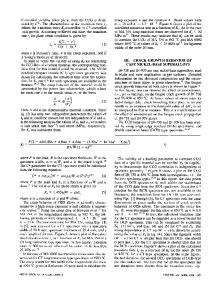Low temperature creep of Ti-6 Al-4 V
- PDF / 1,960,437 Bytes
- 7 Pages / 612 x 783.28 pts Page_size
- 110 Downloads / 338 Views
C R E E P d e f o r m a t i o n of c o m m e r c i a l l y p u r e t i t a n i u m was r e p o r t e d to o c c u r at r o o m t e m p e r a t u r e , below 0.2 Tin, in 1949 b y A d e n s t e d t . ' Since then, c r e e p of t i t a n i u m alloys at a m b i e n t t e m p e r a t u r e s has b e c o m e well known, p a r t i c u l a r l y in the widely used alloys Ti-5 A1-2.5Sn (Ti-5-2.5) and Ti-6AI-4V (Ti-6-4). 2-7 This study was intended to provide more detailed information on the creep of Ti-6-4 than has been available from the brief studies conductedpreviously.2-6 Stresses less than or equal to 80 pct of the yield strength (ay) were of particular interest, since it has been stated6 that "room temperature creep of titanium alloys does not take place below about 85 pct of the yield stress." Most of the existing ambient-temperature creep data on Ti-6-4 were obtained at fairly high stresses (in design terms) such as 80pct ay and above, and rarely for times as long as 500 h. The most extensive work was done on sheet, 3'4 some of it on extra-low interstitial (ELi) material.4 Rolled plate was chosen for this work, and tests were continuedfor 1000 h to obtain a better evaluation of creep behavior. Ti-6-4 is heat-treatable to high strength, and when practical, it would be desirable to heat treat welded structures after assembly. When that is not practical, the creep behavior of Ti-6-4 welds wouldbe important; creep performance of welds was therefore assessed in this work. Finally, the effect of pre-strain on creep of Ti-6-4 was investigated. It has been suggested7 that pre-strains ought to diminish transient creep of titanium alloys at low stresses. It has been pointed out8 that the rate-controlling mechanism of low temperature creep would not be expected to differ from that of ordinary tensile deformation at the same temperature. In the absence of significant recovery, the two kinds of test are physically equivalent, and conclusions about thermally activated processes should be the same for each case. It was shown previously that creep in Ti-5-2.5 at low temperatures exhibited similar activation energies and activation areas as reported for tensile deformation of a variety of titanium alloys. 7 Although insight BEN C. ODEGARD is with Sandia Laboratories, Livermore, Calif. 94550. ANTHONYW. THOMPSON, formerly with Sandia Laboratories, Livermore, Calif., is now with the Science Center, Rockwell International, Thousand Oaks, Calif. 91360. Manuscript submitted August 22, 1973. METALLURGICALTRANSACTIONS
into m e c h a n i s m was not a p r i m a r y a i m , a s i m i l a r c o m p a r i s o n was p l a n n e d for this work on T i - 6 - 4 .
EXPERIMENTAL
PROCEDURE
The material used in all the experiments was from a s i n g l e heat of n o r m a l grade T i - 6 - 4 . The c o m p o s i t i o n as c e r t i f i e d b y the v e n d o r is shown in T a b l e I. Mater i a l was r e c e i v e d in the f o r m of 25 m m - t h i c k r o l l e d plate, f r o m which s p e c i m e n b l a n k s 16 m m in d i a m e t e r w e r e roug
Data Loading...











